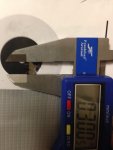
Just shot this group with remington brass.
WHY THE FUCK CAN I NOT REPEAT THESE RESULTS WITH LAPUA BRASS.....
I'm going to tear my hair out.
Before y'all ask, yes I did the following:
1. Play with charges and chrono for fps. (Lapua needs additional .7~ grains to meet same speed as remington brass).
2. Seat depth played with but found my best one .
3. Multiple groups to offset shooter error.
Sent from my iPhone using Tapatalk

